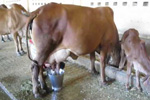 Raw Milk is procured by us from a collective network of over 550 vendors. Balanced & Nutritious Cattle Feed formulation for milch cows and heifers is the starting point of a quality yield. Cattle health & hygiene is accorded paramount importance by Nutra’s vendors since Nutra’s procurement price system incentivizes nutrient rich raw milk.
Raw Milk is procured by us from a collective network of over 550 vendors. Balanced & Nutritious Cattle Feed formulation for milch cows and heifers is the starting point of a quality yield. Cattle health & hygiene is accorded paramount importance by Nutra’s vendors since Nutra’s procurement price system incentivizes nutrient rich raw milk.
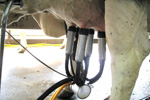 Milking machines are preferred since it is a scientific and modern way to eliminate contamination. Vacuum pumps, which simulate calves suckling, are attached to udders and the raw milk extracted is directly pumped into sealed containers without exposure to atmospheric dirt. The udders are disinfected before & after milking while the Milking machines are similarly sterilized.
Milking machines are preferred since it is a scientific and modern way to eliminate contamination. Vacuum pumps, which simulate calves suckling, are attached to udders and the raw milk extracted is directly pumped into sealed containers without exposure to atmospheric dirt. The udders are disinfected before & after milking while the Milking machines are similarly sterilized.
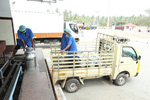
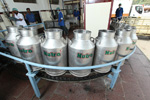
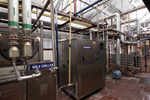
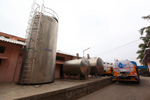 Raw milk, thus collected, is immediately transported to Collection Centers where it is tested for Fat and nutrients called SNF ( Solids Not Fat ) using Milk Analyzers. Raw milk consolidated at Collection Centers is instantly transported to the Processing Factory or to Milk Chilling Plants, if the Main Processing Plant is more than 40 kms away from the Collection Centers. Raw milk received at the Chilling Plant is chilled to 4 deg C so that bacteria multiplication is arrested. The chilled milk is then transported to the Main Processing Plant in refrigerated, insulated road tankers.
Raw milk, thus collected, is immediately transported to Collection Centers where it is tested for Fat and nutrients called SNF ( Solids Not Fat ) using Milk Analyzers. Raw milk consolidated at Collection Centers is instantly transported to the Processing Factory or to Milk Chilling Plants, if the Main Processing Plant is more than 40 kms away from the Collection Centers. Raw milk received at the Chilling Plant is chilled to 4 deg C so that bacteria multiplication is arrested. The chilled milk is then transported to the Main Processing Plant in refrigerated, insulated road tankers.
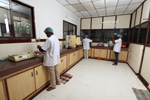
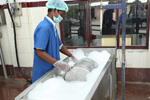 At the Processing Plant, raw milk received from the Collection Centers & Chilling Plants is subjected to stringent quality tests like. If the milk fails even one of these tests, it is rejected. The Stainless Steel Milk cans are sterilized and returned to the Collection Centers.
At the Processing Plant, raw milk received from the Collection Centers & Chilling Plants is subjected to stringent quality tests like. If the milk fails even one of these tests, it is rejected. The Stainless Steel Milk cans are sterilized and returned to the Collection Centers.
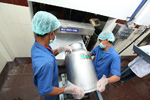
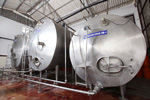 Quality cleared raw milk is weighed, tested for Fat/SNF and moved to the Dump Tank. The milk is then chilled to 4 deg C and stored in insulated Raw Milk Storage Tanks for processing. Chilled milk is then drawn to the Pasteurizer where it is subjected to very high temperatures for 20 seconds thus completely destroying all disease producing organisms. After pasteurization, the milk is again chilled to 4 deg C.
Quality cleared raw milk is weighed, tested for Fat/SNF and moved to the Dump Tank. The milk is then chilled to 4 deg C and stored in insulated Raw Milk Storage Tanks for processing. Chilled milk is then drawn to the Pasteurizer where it is subjected to very high temperatures for 20 seconds thus completely destroying all disease producing organisms. After pasteurization, the milk is again chilled to 4 deg C.
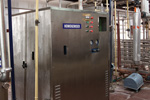
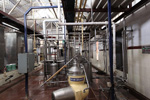 The milk then passes through a high pressure Homogenizer where the Fat is disintegrated to 2 micron size and uniformly distributed in the milk. In the Separator, the milk is spun through a centrifuge to separate the cream. The cream and milk are then remixed to provide the desired Fat content in each variant of milk as per FSSAI norms ( Toned, Double Toned , Full Cream or Standardized ).
The milk then passes through a high pressure Homogenizer where the Fat is disintegrated to 2 micron size and uniformly distributed in the milk. In the Separator, the milk is spun through a centrifuge to separate the cream. The cream and milk are then remixed to provide the desired Fat content in each variant of milk as per FSSAI norms ( Toned, Double Toned , Full Cream or Standardized ).
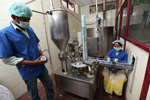
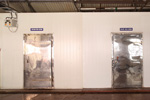 Standardized milk is also used for Curd preparation. The milk is heated to 40 deg C and culture is added & mixed thoroughly. The milk is packed in cups by automatic cup filling machines and kept in Incubation Room till the curd is formed. After that, the Curd Cups are moved to the Blast Cold Room where the temperature is abruptly & drastically brought down to accelerate Curd curing before being moved to the regular Cold Storage Chamber.
Standardized milk is also used for Curd preparation. The milk is heated to 40 deg C and culture is added & mixed thoroughly. The milk is packed in cups by automatic cup filling machines and kept in Incubation Room till the curd is formed. After that, the Curd Cups are moved to the Blast Cold Room where the temperature is abruptly & drastically brought down to accelerate Curd curing before being moved to the regular Cold Storage Chamber.
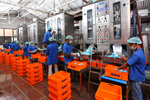
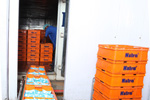 Processed Milk variants are then packed in pouches of 200ml to 1 liter using Automatic Pouch Filling Machines, stacked in 12 liter Crates and sent into Cold Storage Chambers through Conveyor Belts where it is kept for around 5 hours at less than 4 deg C before being dispatched to the markets in insulated, refrigerated trucks.
Processed Milk variants are then packed in pouches of 200ml to 1 liter using Automatic Pouch Filling Machines, stacked in 12 liter Crates and sent into Cold Storage Chambers through Conveyor Belts where it is kept for around 5 hours at less than 4 deg C before being dispatched to the markets in insulated, refrigerated trucks.
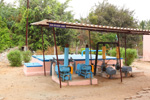
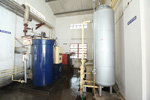 Milk, being extremely sensitive to contamination and perishable by nature , needs to be processed in a sterile environment. At each stage of the process, all milk handling surfaces need to be thoroughly cleaned and sanitized. This results in a sizeable quantum of wash water being generated which require treatment & disposal. Wash water is collected in a Raw Effluent Sump and pumped into a Two Stage state-of-the-art Effluent Treatment Plant in a uniformly regulated flow so as to reduce BOD & COD.
Milk, being extremely sensitive to contamination and perishable by nature , needs to be processed in a sterile environment. At each stage of the process, all milk handling surfaces need to be thoroughly cleaned and sanitized. This results in a sizeable quantum of wash water being generated which require treatment & disposal. Wash water is collected in a Raw Effluent Sump and pumped into a Two Stage state-of-the-art Effluent Treatment Plant in a uniformly regulated flow so as to reduce BOD & COD.
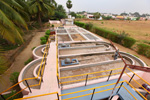
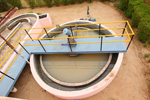 The Anaerobic Fixed Film Reactor reduces most of the effluents and regulates the flow into extended aeration tanks where the remaining effluents are treated. The entire wash water generated at our Processing Plant is fully treated at the ETP to meet the Pollution Control Board norms and is used for greenbelt irrigation within the plant premises.
The Anaerobic Fixed Film Reactor reduces most of the effluents and regulates the flow into extended aeration tanks where the remaining effluents are treated. The entire wash water generated at our Processing Plant is fully treated at the ETP to meet the Pollution Control Board norms and is used for greenbelt irrigation within the plant premises.